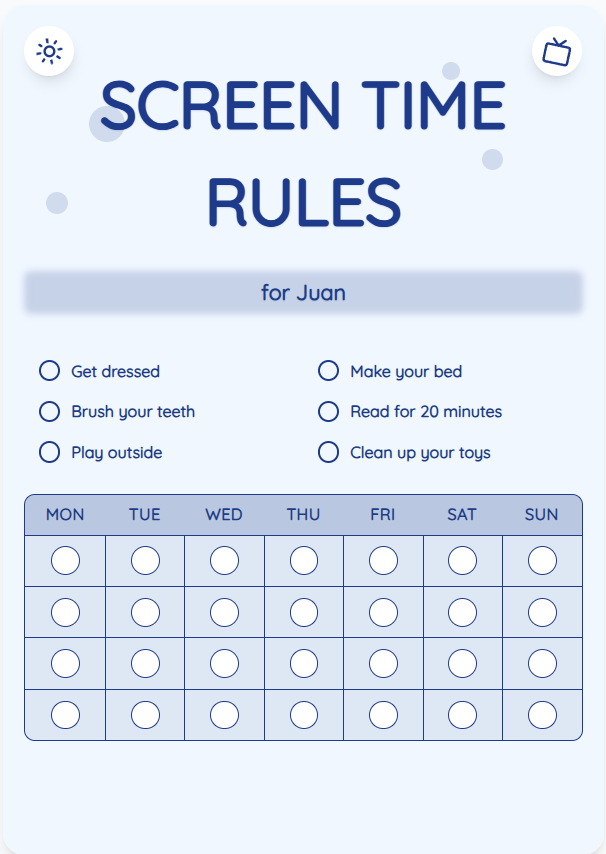Managing Screen Time 24 Hours for Children: A Parent's Guide
In a world where screens dominate daily life, finding a balance between technology use and other activities is crucial for children's development. As a parent, navigating the realm of screen time management can be challenging, especially when faced with the concept of screen time over 24 hours. This guide offers practical advice and tips to help you establish healthy screen time habits for your child aged 2-12.
See What Your Screen Time Chart Will Look Like
Here's an example of a beautiful, customizable screen time rules chart you can create for your family

Understanding the Impact of Excessive Screen Time
Excessive screen time can have detrimental effects on a child's physical health, mental well-being, and social skills. Studies have linked prolonged screen exposure to issues such as obesity, sleep disturbances, and delayed cognitive development. By recognizing the risks associated with unrestricted screen time, parents can take proactive steps to limit their child's device usage.
Setting Screen Time Limits
Establishing clear guidelines on when and how long your child can use screens is essential. Consider creating a screen time chart using tools like ScreenTimeRules.com to visually represent and track your child's daily screen time allowance. Encourage breaks for physical activity, social interaction, and creative play to ensure a well-rounded routine.
Put These Tips Into Action
Create a custom chart to implement these strategies with your child
Promoting Healthy Alternatives
Encourage your child to engage in activities that promote physical, mental, and emotional well-being. Encouraging outdoor play, reading books together, and pursuing hobbies can help reduce reliance on screens. By modeling a balanced approach to technology use and fostering a love for non-screen activities, you can instill lifelong habits that benefit your child's overall development.
Practical Tips for Success
- Create a designated 'screen-free' zone in your home.
- Engage in open conversations with your child about the importance of balance.
- Use positive reinforcement to reward adherence to screen time limits.
- Involve your child in creating their own screen time schedule.
Frequently Asked Questions
Is it okay for my child to have screen time before bed?
Avoiding screens before bedtime is recommended as the blue light emitted can disrupt sleep patterns. Establish a 'digital curfew' at least an hour before bedtime to promote restful sleep.
How can I monitor my child's screen time without being too restrictive?
Utilize parental control apps or features on devices to set time limits and track usage. Communicate openly with your child about the reasons behind monitoring screen time to foster understanding.
What should I do if my child resists screen time limits?
Address resistance with empathy and understanding. Offer alternative activities and involve your child in decision-making regarding their screen time allowance. Consistency and positive reinforcement can help overcome initial resistance.
Finding the right balance in managing your child's screen time is a journey that requires patience and adaptability. By implementing the practical tips provided in this guide and utilizing tools like screen time charts, you can create a harmonious environment where technology complements rather than dominates family life. Start empowering your child with healthy screen habits today!
Ready to Transform Your Family's Screen Time?
Join thousands of parents who have successfully managed screen time with our customizable charts.
